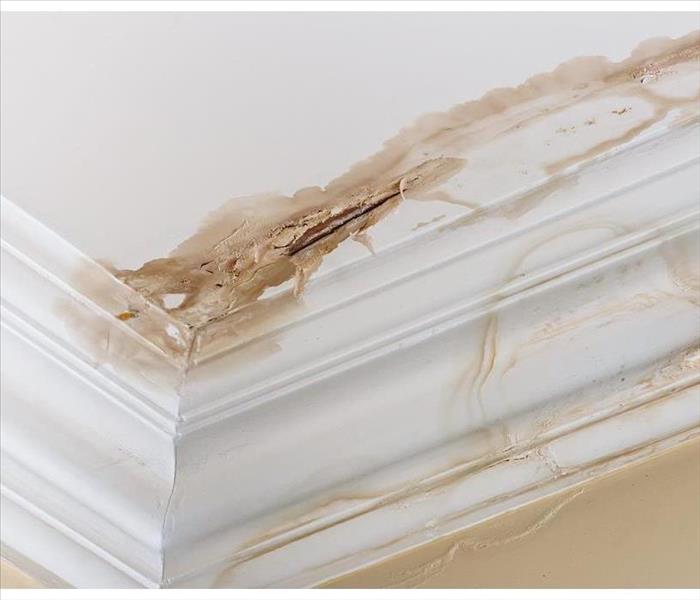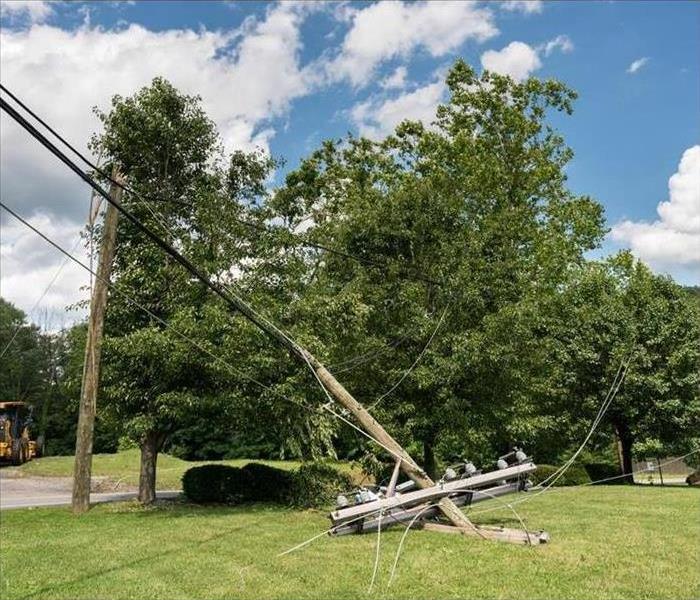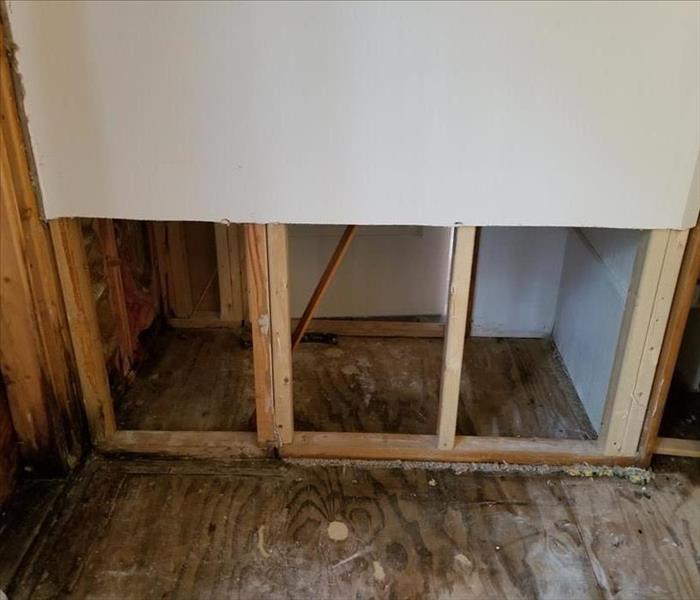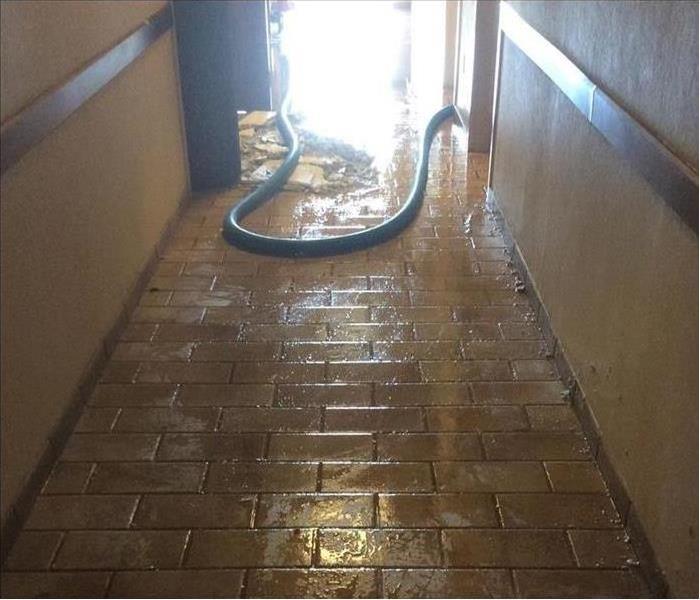Archived Storm Damage Blog Posts
The Importance of Prompt Storm Damage Cleanup: Mitigating Risks and Restoring Your Home
1/4/2024 (Permalink)
Natural disasters, such as storms and hurricanes, can cause devastating damage to our homes and communities. In the aftermath of these events, it's essential to take swift action to mitigate further damage and restore our properties. Delaying storm damage cleanup can lead to significant problems, such as mold growth and structural damage. In this blog, we will explore the importance of prompt storm damage cleanup and how taking quick action can protect your home and ensure a faster and more efficient recovery.
The Risks of Delaying Storm Damage Cleanup
- Discussing the potential consequences of waiting to address storm damage, such as weakened structures and further water damage.
- Highlighting the risk of mold growth from water damage, which can cause health issues and complicate the restoration process.
- Emphasizing the importance of acting fast to mitigate risks and prevent secondary damages.
Minimizing Further Damage with Immediate Cleanup
- Detailing the importance of taking action as soon as it's safe to enter your home after a storm.
- Discussing the key steps involved in prompt cleanup, such as removing standing water, drying out materials, and inspecting for structural damage.
- Highlighting the benefits of quick action, including the minimization of risks and more straightforward restoration efforts.
Professional Storm Damage Cleanup Services
- Exploring the advantages of hiring professional storm cleanup services, such as SERVPRO®, to handle the restoration process.
- Discussing the expertise and specialized equipment that professionals bring to the recovery process, such as industrial-grade dehumidifiers and air movers.
- Highlighting the benefits of a comprehensive restoration plan, which addresses all aspects of storm damage, including water extraction, damage assessment, and structural repairs.
Protecting Your Health During Cleanup
- Discussing the potential hazards associated with storm damage, such as mold growth and exposure to harmful chemicals.
- Highlighting the importance of proper safety gear, such as gloves and masks, during cleanup to minimize exposure to hazards.
- Educating homeowners on the significance of avoiding any areas that may present potential health hazards and leaving those areas to the professionals.
A Faster and More Efficient Recovery
- Discussing the benefits of a swift and comprehensive storm cleanup in speeding up the recovery process.
- Highlighting the role that professional restoration services play in minimizing costly damage and reducing the overall cost of recovery efforts.
- Emphasizing the importance of not delaying cleanup to avoid compounding the damage and lengthening the restoration process.
Prompt storm damage cleanup is crucial in minimizing risks and restoring your home as quickly and effectively as possible. By acting fast and enlisting the services of professional restoration companies, such as SERVPRO®, you can mitigate further damage, protect your health, and ensure a faster and more efficient recovery. Don't delay – take action today to restore your home and regain a sense of normalcy after a storm.
The Importance of Prompt Storm Damage Cleanup
10/3/2023 (Permalink)
Storms can wreak havoc on our homes and communities, causing significant damage and disrupting our lives. Whether it's a severe thunderstorm, hurricane, or tornado, the aftermath of such events can be overwhelming. One crucial aspect often overlooked is the prompt cleanup of storm damage. In this blog post, we will explore the importance of timely storm damage cleanup and its various benefits.
Minimizing Further Damage
After a storm, your property may be left with debris, fallen trees, damaged structures, and waterlogged areas. If left unaddressed, these can lead to additional damage. Prompt storm damage cleanup is essential in minimizing further harm to your property. With debris cleared and damaged structures secured, you can prevent potential hazards and save yourself from more extensive and costly repairs down the line.
Restoring Safety
Storm damage can pose safety risks, both immediate and long-term. Fallen trees and unstable structures can be hazardous to people and pets. There is also the risk of exposed electrical wires, weakened foundations, and weakened structures, which can lead to accidents and injuries. By promptly addressing storm damage, you can restore safety to your property, protecting yourself and your loved ones from potential harm.
Preventing Mold and Water Damage
Water intrusion is a common issue after storms, especially if there are leaks or flooding. Excessive moisture can lead to mold growth, which not only damages your property but also poses health risks. Mold can cause respiratory issues, allergies, and other health problems. By promptly cleaning up water damage and addressing moisture issues, you can prevent the onset of mold growth and reduce the risk of related health issues.
Insurance Purposes
Timely storm damage cleanup is crucial for insurance purposes. Most homeowners' insurance policies require policyholders to take immediate action to prevent further damage after a storm. Failure to do so may result in the denial of your insurance claim or limited coverage. By promptly cleaning up and documenting the damage, you can ensure that your insurance claim is processed smoothly, and you receive the coverage you are entitled to.
Restoring Normalcy
Storm damage can disrupt our daily lives and routines. Cleaning up the debris, repairing damage, and restoring your property to its pre-storm condition can help bring back a sense of normalcy. It allows you to return to your home or business, resume your regular activities, and move forward after a challenging event.
Environmental Impact
Prompt storm damage cleanup also plays a role in reducing the environmental impact of a storm. Debris left uncleared can contribute to pollution and harm ecosystems. By properly disposing of debris, recycling materials when possible, and addressing any hazardous materials, you can contribute to a cleaner and healthier environment.
Prompt storm damage cleanup is essential for minimizing further damage, restoring safety, preventing mold and water damage, complying with insurance requirements, and restoring normalcy after a storm. It not only protects your property and belongings but also ensures the well-being of your loved ones. If you have experienced storm damage, don't delay in taking action. Consult with professionals and take the necessary steps to clean up and restore your property promptly. By doing so, you can move forward and rebuild after the storm with confidence.
How to Inspect Your Home After a Storm
1/10/2023 (Permalink)
 Roof leak found in a home in Tyler, TX.
Roof leak found in a home in Tyler, TX.
A storm is powerful. It can knock over trees, blow out windows and doors, and cause damage to your home. If a storm is coming your way, it's important to prepare for it by securing loose objects outside the house and making sure all household members know where to go during an emergency (the basement or an interior room away from windows). It's also important to inspect your property after the storm has passed. Here are some things you should check in order to make sure your home isn't damaged:
Roof Leaks
After a storm, it's common to find your home has been damaged in some way. A roof leak is one of the most common types of damage and can cause serious problems if left unattended. If you notice any signs of a leak in your roof, take action immediately!
If you notice water stains on the ceiling, it is likely that your attic has a leak. The first step in determining whether this is true, or if the stains are simply due to condensation, is to visually inspect your attic. Look for any signs of damage or leaks such as molding or insulation that may be wet and discolored. If there are no visible signs of leakage, check around the perimeter of your roofline for drips coming from seams in shingles or flashing materials such as metal flashing or roof vents.
Look for damp insulation or interior walls. If you have discovered that there is water coming through the ceiling in one area of your home, it's time to act fast! Many homeowners don't realize how much damage can be done by even small leaks until they've soaked into their walls and insulation for several days or weeks—so if you find any signs that moisture may have gotten into these areas (such as discoloration), call someone who specializes in flood damage extraction immediately.
Damaged Siding and Gutters
Cracks in the siding are are a sign of water damage to the wood framing behind it and should be repaired immediately. A leaky roof or gutter can cause the exterior walls of your home to crack and warp from exposure to moisture. If you find any cracks in your siding, carefully remove any debris that may be blocking them so that they can dry out properly.
Leaking gutters can cause water damage to your home and personal belongings. Make sure to inspect the gutters for any damage, debris, or missing pieces. If you find any of these issues, you will need to replace the gutter system altogether or repair it before heavy rain comes again. Look for leaks at every connection point between your gutters and downspouts to ensure there are no gaps where water can seep into your attic or crawl space below. Make sure all fasteners are secure and tighten loose ones as needed; replace any missing pieces if necessary.
Damaged Windows and Screens
Windows are vulnerable to damage during a storm. If you have any broken windows or cracked glass, look for leaks and cracks around the frame of the window as well.
If your screens have been damaged by flying debris or falling branches, make sure to replace them as soon as possible. Screens that are torn can allow insects and other pests into your home and cause health issues in warmer months if left untreated.
The most important thing you can do to protect your home is to inspect it after every storm. If you notice any damage, get it fixed as soon as possible. Remember that a little bit of work now could save you from costly repairs later on down the line! If you do experience storm damage in your Tyler, TX home, SERVPRO of Tyler is here to help you get back on your feet. Give us a call!
What To Do When You Lose Power
8/31/2022 (Permalink)
 Power outage in Whitehouse, TX area
Power outage in Whitehouse, TX area
What To Do When You Lose Power
Ice, snow, and high winds can wreak havoc upon power lines. Storm season means an increased chance of a power outage. Losing power at your business in Whitehouse, TX, doesn't have to mean losing valuable data or working hours, though. There are a few things you can do to make sure all your files are saved and accessible for workers.
Have a Generator
Every building should have at least one portable generator that can keep the power going when the municipal supply is cut off. A backup generator can help maintain electricity to various items:
- Basement sump pumps
- Office equipment
- Lights
- Computers
- Heating system
- Fire system
A generator not only keeps your business running but also keeps your building protected from certain hazards that may accompany the storm. If the basement floods, for example, remediation experts can resolve your problem faster if you have a working sump pump to remove most of the water before they arrive. You can save a lot of money on repairs and lost revenue if you can maintain basic functions after a power outage.
Seek Alternate Sources
Between the time when the power goes out and the generator kicks in, it's helpful to have sources that can help employees save what they're working on. Plugging each computer into an uninterrupted power supply does just that. The UPS lets the device run on its battery until another power source can take over. Because it's difficult to predict how long you may be without power, especially if you don't have a generator, it's important to make sure that the battery is strong and that employees only use their computers for essential functions so that it can last as long as possible.
A power outage doesn't have to spark widespread panic as employees lament the loss of documents they worked hard to create. By taking a couple of precautions, you can implement solutions that outlast the blackout.
How To Conduct an Emergency Drill at Work
7/21/2022 (Permalink)
 Make sure all employees are trained to know where to meet and how to get there.
Make sure all employees are trained to know where to meet and how to get there.
Creating a fire drill procedure is the best way to make sure your employees and visitors get to a safe place quickly in case of an emergency, such as a fire or other disaster. When developing the plan, include the following steps for an effective evacuation.
Steps To Follow When Creating an Evacuation Plan
Alert your local fire department before you conduct a drill. The Fire Marshall will be happy to visit your facility and give you helpful suggestions so that you can identify the best evacuation routes to get people to safety quickly.
Develop a safety committee and make sure to meet regularly. It’s important to include a person from each department and shift who will account for employees at the designated meeting places outside the building. Once evacuation routes have been established, post the fire drill paths with maps in all areas of the facility.
Make sure you have a reliable alarm system that everyone in the building is able to hear. In areas where the noise level is high, or if you have an employee who is hearing impaired, you need to make sure there are flashing lights or another visual alarm that can’t be missed. Alarms should be checked periodically to ensure they are working properly.
Make sure all employees are trained to know where to meet and how to get there. Conduct a drill periodically to ensure that everyone is accounted for quickly and efficiently. Don’t forget to account for all the visitors in your building. Having a sign-in sheet at the reception area will help identify all visitors to your business.
Steps To Making the Plan a Success
When you are implementing a fire drill plan, it is important to repeat the exercise several times so that your employees become comfortable with the process.
Flood Cuts 101
6/7/2022 (Permalink)
 A flood cut was performed in a home in Flint, TX.
A flood cut was performed in a home in Flint, TX.
After flooding occurs at your Flint, TX, home, it may be necessary to tear out part of the drywall in the affected area to address contamination and other concerns. While the temptation to take a hammer to your soggy drywall may be (understandably) high after a flood, a flood cut is the smarter move.
What Is a Flood Cut?
When your preferred water damage restoration company gets down to work, one of the first things the team may want to do is make a flood cut to your drywall. This is a calculated cut performed at least 12 inches above the highest spot reached by the creeping water. Because of this, it typically results in half of the lower part of the wall being cut away.
Are Flood Cuts Necessary After Any Kind of Flooding?
Any time rising water affects your home, a flood cut may be required. That said, it's most commonly associated with severe weather events such as the following:
- Thunderstorms
- Tropical storms
- Hurricanes
- Rivers, lakes and streams overflowing
- Overflowing dams and similar barriers
What's So Bad About Rising Water?
There are two main reasons why rising water is a problem for your drywall. First, it's often classified as Category 3 water, a.k.a. black water, due to how highly contaminated it is. All water from storm surges and sewage, for example, is considered Category 3.
What's more, once the drywall is touched by Category 3 water, it's impossible to ever get it fully clean. This is due to its porous surface; once those pathogens or other toxins get in, they're never coming back out in their entirety.
After flooding, it's imperative to remove any sodden items from your home for the continued safety of everyone who lives there. This goes double for wet drywall. With a flood cut, trusted professionals gain better access to the source of the problem and will dispose of any contaminated building materials safely — and with zero involvement from you.
Mitigation and Restoration Are Essential Stages of Water Damage Cleanup
4/4/2022 (Permalink)
 Flood damage in Arp, TX.
Flood damage in Arp, TX.
When a flood cleanup company examines a water-logged facility, the team should discuss two cleanup stages: mitigation and restoration. What are they different, and why are both vital to repair? It's probably tempting to dry everything out move on, but the specialists should explain that in cases of water damage, that effort isn't enough. Owners must consider both phases because prevention and rebuilding are vital to securing the area. Collaborate to establish a plan of action that gets your operations back up and running without concerns of future issues.
What Happens During Mitigation?
When the storm ends, and the water recedes, a restoration company should immediately attend to the property. The fluid from rain and floods permeates into porous materials. This lingering moisture, if not appropriately treated, permits mold, mildew and bacteria to develop. Rot and structural integrity could also become issues such as wood and ceilings. The goal of mitigation is to reduce the likelihood of these secondary conditions.
A flood cleanup company in Arp, TX, works with certified environmental specialists to assess the premises, testing to determine where contamination exists and how to treat it best. Within hours, the crew begins drying efforts. The workers should complete the following actions:
- Pull up saturated carpet
- Remove damp objects for content cleaning
- Toss soiled valuables
- Run industrial dehumidifiers
- Perform necessary flood cuts
Once the room is dry, the team scrubs the walls and sanitizes them with antimicrobial spray.
How Is Restoration Different?
While the early efforts focus on minimizing further concerns, the restoration company concentrates on mending the physical structure. This part of the project is slower. In remediation, crew members accomplish tasks at the same time. During the restoration, workers rebuild. Often, workers complete one thing before moving on to the next. Staff members replace anything pulled out, patch the walls and add a coat of paint. They also return any valuables that they salvaged.
A flood cleanup company understands that preventative measures are necessary. Their efforts with mitigation save owners future hassles. It's tempting to want to dry and paint, but taking time to care for the space is vital.
4 Reasons Flood Cuts Are Important
3/27/2022 (Permalink)
 Flood cuts performed in New Hope, TX.
Flood cuts performed in New Hope, TX.
Flood Cuts Are Important For 4 Reasons
Enduring flooding can be a devastating experience for any homeowner in New Hope, TX. Salvaging the remains of your home once waters recede can also be extremely daunting. To safeguard your residence from additional damage, promptly initiating the flood cleanup and restoration process is essential. This may include making flood cuts on damaged walls. While this practice may appear destructive, tearing out saturated drywall is often an important procedure that shouldn’t be ignored.
1. Eliminates Contaminated Objects
Floods can introduce unsanitary water and debris into your home, creating an unhealthy environment for you and your family. Completing a tear-out on every affected wall helps eliminate potentially detrimental contamination.
2. Ensures Removal of Wet Materials
Because drywall is porous, water can easily seep through the structure and saturate underlying insulation. This may be problematic because wet building materials can easily become breeding grounds for mold. To alleviate this subsequent flooding concern, it’s essential to promptly remove all water-damaged items. Cutting the wall 12 to 18 inches above the highest water level ensures that all damp objects are efficiently removed.
3. Reduces Risk of Hidden Mold
Mold thrives in moist environments, often proliferating undetected in hidden zones. Failure to complete necessary flood cuts and remove saturated building materials can result in extensive growth. A large colony can compromise your home’s structural integrity, resulting in additional destruction.
4. Enables Moisture Verification
Eliminating excessive moisture is a crucial cleanup procedure. Removing wet drywall and insulation helps the affected area dry more efficiently. It also allows restoration experts to verify the absence of moisture throughout the water-damaged space before finalizing repairs, further reducing the risk of mold contamination.
Flooding can be an unexpected and extremely destructive event. Recognizing the importance of performing flood cuts and eliminating saturated building materials can help every homeowner commence cleanup operations quickly and efficiently, sparing their homes from mold proliferation and potentially costly remediation needs.
Preparing Your Commercial Building for a Hurricane
2/1/2022 (Permalink)
 Install shutters on your windows to keep out flying debris
Install shutters on your windows to keep out flying debris
Do Not Let Hurricane Damage Destroy Your Building
You probably take steps to protect your home from hurricane damage. Yet your commercial property in Tyler, TX, could be affected by high winds and heavy rain, as well. In fact, 40 percent of small businesses that close due to hurricanes never re-open.
You thus need to secure your headquarters so you can keep the company running immediately after the storm. Here are some ways to prepare your commercial premises for a hurricane.
- Protect Key Documents
Even in this digital age, you probably still have important paper documents that are hard to reproduce. Legal contracts, accounting statements, tax returns, and insurance documents are common examples. Seal these and other similar papers in waterproof containers before the storm comes.
You should also keep the contact information for people who are most essential to your business. This could be employees, accountants, or lawyers. Put this information in an off-site location.
- Make a Checklist
Write a list of everything your employees will need if your building sustains severe hurricane damage during work hours. Gather all of those items and place them in an easily accessible location within your property.
Your storm-preparation kit should include a three-day supply of water and non-perishable food. It should also have sleeping items such as cots, pillows, blankets, and chairs. You may additionally want to store a battery-operated radio and a camera for documenting the destruction to the building.
Finally, be sure to put emergency contact information into the kit. Include the phone numbers for the Small Business Administration, your insurance provider, and a storm cleanup company.
- Protect the Premises
While restoration experts can help you rebuild your property after the storm, you should also try to protect the building as much as possible. Install shutters on your windows to keep out flying debris. Additionally, cut any trees or branches that are too close to the structure.
Do not let hurricane damage destroy your business. By preparing in advance of the storm, you can mitigate the harm.



 24/7 Emergency Service
24/7 Emergency Service






